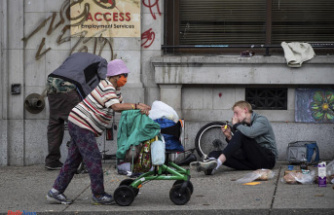When Apple invites you into its showrooms to show the latest models, everything has to be perfect. iPhones, iPads and iMacs are aligned symmetrically, the light is adjusted so that there are no disruptive reflections. Each surface is polished beforehand so that no fingerprints can be seen.
But in Breda, a small town in the Netherlands 100 kilometers south of Amsterdam, things are different. Basically, you are not allowed to enter here at all. Apple rarely makes an exception. Because there are no shiny iPhones to be seen here. On the contrary: Devices that make it here are doomed. And this ending lasts exactly 18 seconds. That's how long it takes Daisy to completely disassemble an iPhone with her claws.
The robot, which is standing in a factory building in an industrial area, is not very squeamish. He grabs an old iPhone, first removes the display, then brutally punches out the screws. The entire device is then shock frozen to minus 80 degrees so that the adhesive breaks and the battery can then be tapped out. Now Daisy passes the remains on to the next gripper arm, because there are other small parts that are surgically removed: speakers, vibration motors, memory, camera lenses, circuit boards.
Why is Apple bothering? Because the iPhone contains valuable raw materials that are worth the effort: tungsten, steel, aluminum, copper, gold and even rare earths. By 2030, Apple not only wants to be climate-neutral, but also to have a complete material cycle. Robot Daisy is in competition with two alternative ways that are currently even more resource-efficient when it comes to dealing with discarded smartphones: repair and resale.
Daisy is only found twice in the world, except in Breda and in Austin, Texas. "We are well on the way to eventually being able to manufacture our products without mining any raw materials at all," says Lisa Jackson, the top manager responsible for environmental and political initiatives. A ton of iPhone components removed by Daisy contains gold and copper from 2,000 tons of rock that had to be mined to extract the metal.
However, the recycling idea is still in its infancy. Even under full load, which has not yet been reached, the two machines can only disassemble 2.4 million iPhones per year. In relation to the overall business, this is negligible. Apple sold 240 million devices last year. Basically, Daisy isn't even a recycling robot. Because their gripper arms and punches only take the parts apart.
The small parts then end up in large boxes, which in turn are sent to recyclers who extract the raw materials from them. From there, Apple then buys back recycled material. Last year, one-fifth of the materials used in Apple products came from these sources, and nearly 60 percent for aluminum.
Nevertheless, Daisy is something special. The machine conserves resources compared to other recycling methods. Usually, large parts of electronic products are simply shredded. This damages the components so much that many of the recyclable materials are no longer usable. The result is a mixture of plastic and metal - and a contaminated mass of debris.
Rare earths cannot be recovered in this way. If this were different, it would also make companies independent of raw material supplies from regions that are part of geopolitical conflicts. By far the largest supplier of rare earths is China.
Apple has been criticized for years for making a better method than recycling more difficult: repair. The service provider iFixit regularly examines how easy smartphones can be repaired and awards points from zero, is not repairable, to 10, is the easiest to repair. The iPhone 13 Pro got a six. While durability has improved over the years, there is "still no easy way to replace the rear glass," the statement said.
In the USA, under pressure from the legislature, Apple has meanwhile started a self-repair program. If you want to repair your newer iPhone model there, you can order the necessary spare parts, tools and repair instructions from Apple's online shop.
A journalist from the news portal "The Verge" tried it out - and wouldn't recommend it. He was sent two large suitcases with tools that weighed 36 kilograms. He also had to pay $49 rent for the tool and post a $1,200 deposit. The battery he wanted to replace cost $69. A repair order in the Apple Store would have been significantly cheaper.
Manufacturers are now willing to trade in old models. According to Apple, last year it took back 12.2 million devices and accessories, cleaned them, repaired them and resold them as refurbished. But most used iPhones are likely to be sold privately past Apple - probably the most environmentally friendly form of recycling. Some of them get to know other robots that are in a factory building in Falkensee.
Rebuy, which claims to be the largest company for used electronics in Europe, has built a so-called grading plant here in the west of Berlin, which is unique in Europe. In the meantime, the number of smartphones sent in has become so large that it is no longer people who assess the condition of the devices, but machines.
Rebuy buys used smartphones and resells them. Last year there were half a million devices. Only iPhones were among the top 5 models. "Recommerce is more environmentally friendly than recycling," says Rebuy boss Philipp Gattner. "Buying and selling used products is not only easy on the wallet, it also protects our environment and saves resources." The circular economy must become a matter of course.
As in Breda with Apple, metal arms grip the devices in Falkensee, but they handle them carefully. They are carefully pushed into small boxes, where they are automatically inspected: cameras scan the housing to find scratches. Artificial fingers tap on the devices' displays to test their functionality. Previously, specially developed software was loaded onto the models, which is able to check the health of batteries and other parts.
Whenever Apple has introduced new models, the machines at Rebuy run at full speed and process thousands of used smartphones every day. Because many users throw away their old devices when they buy a new model. "We could still sell a lot more than we're offered," says Rebuy boss Gattner.
In practice, very few smartphones are used for more than two or three years. They are being replaced by new models, although they still work well. However, most of these do not end up in the circular economy either. According to the Bitkom digital association, 200 million old smartphones are stored in a completely different place in Germany: in the drawers of German citizens.












